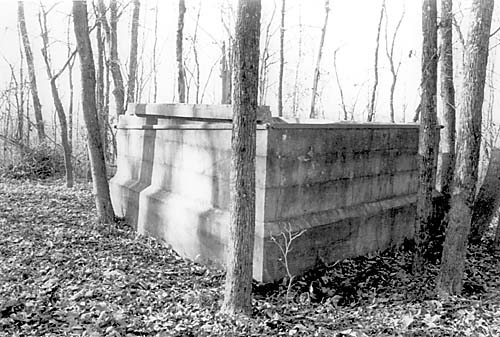
Ikie’s Tomb in rural Pleasants County has been the subject of
eerie tales and legends for most of a century. Author John Tice
decided to explore the truth behind this legend and discovered a
very real — if chilling — story. Photograph by John
Tice.
Searching for Ikie’s Tomb
Text and photographs by John Tice
I was 14 years old when I first visited Ikie's Tomb. It was a cool fall evening. My father told my younger brother Jared and me that he had something special planned for us. We jumped into his old Ford and headed toward the family farm — more than 500 acres of Pleasants County hayfield and forest known as Sugar Creek, named after the small run that meanders through the valley.
It was dusk by the time our truck tires hit the gravel road that winds along the side of Sugar Creek. As we neared the old farmhouse, I got a strange feeling — a mixture of comfort and awe brought about by the stories passed down to me over the years about this place. My great?great?great?great-grandfather Christopher Wagner settled this land in 1820. My Mamaw and Papaw had lived here for many years, and my father played here as a child.
This time, however, Dad drove past it. A quarter-mile up the road stood the old Waldo Wagner place — a farm once owned by my great?uncle Waldo — now just a series of weathered barns and a decaying farmhouse. Beside it, Wolf Run flowed down from the hills and into Sugar Creek. We parked just off the road near the mouth of the run. Dad got out his flashlight, and we headed by foot up a small road that followed Wolf Run. I didn't like that road, especially at night. Mamaw always told me it was haunted, saying that when she walked the road alone as a young girl, she could hear footsteps behind her. When she would turn around to look, there was never anybody there.
My brother Jared hustled to keep up with us as the road slanted upward. My father didn't speak until we reached a small clearing at the top of the hill. We came to a stop, and Dad shined the flashlight across the small field, revealing a number of headstones, overgrown with brush and weathered by time.
" Boys," he said slowly, "this is Mount Welcome Cemetery." He led us closer to the graves and pointed out the foundation of a church building nearby. Only the four cornerstones and steps leading to nowhere remained. "This is where your grandma went to church. Everybody around here went to Mount Welcome Church back in the day.” I asked Dad if this was the only reason we came all this way. "No," he replied. "You still have to see Ikie's Tomb."
Dad led us several hundred yards around the top of the hill and back into the woods. He stopped and shined the flashlight on what appeared to be a small concrete building. This was Ikie’s Tomb. It had been here for most of a century and is the source of countless legends and tales still circulated among the people of Pleasants County. Stories are often told about a young boy, his mysterious death, and his unusual burial here with his siblings, his toys, and other objects.
Dad walked up to the side of the ominous 10' x 10' structure. We had no choice but to follow — he had the only flashlight. There was a door that had been concreted shut and a small broken window on one side overlooking the hill. He shone the light through the window's narrow opening to reveal a small broken crypt inside the mausoleum, surrounded by dead leaves and large chunks of concrete. "The roof caved in years ago," Dad said. "They took Ikie's body out and buried him somewhere nearby — I don't know what became of all his toys. Some might still be in there." Jared and I were stiff with fear, but tried not to let Dad know it. As we walked away from Ikie's Tomb that night, I tried to shake the images going through my teenage head.
You can read the rest of this article in the Fall 2003 issue of Goldenseal, available in bookstores, libraries or direct from Goldenseal.